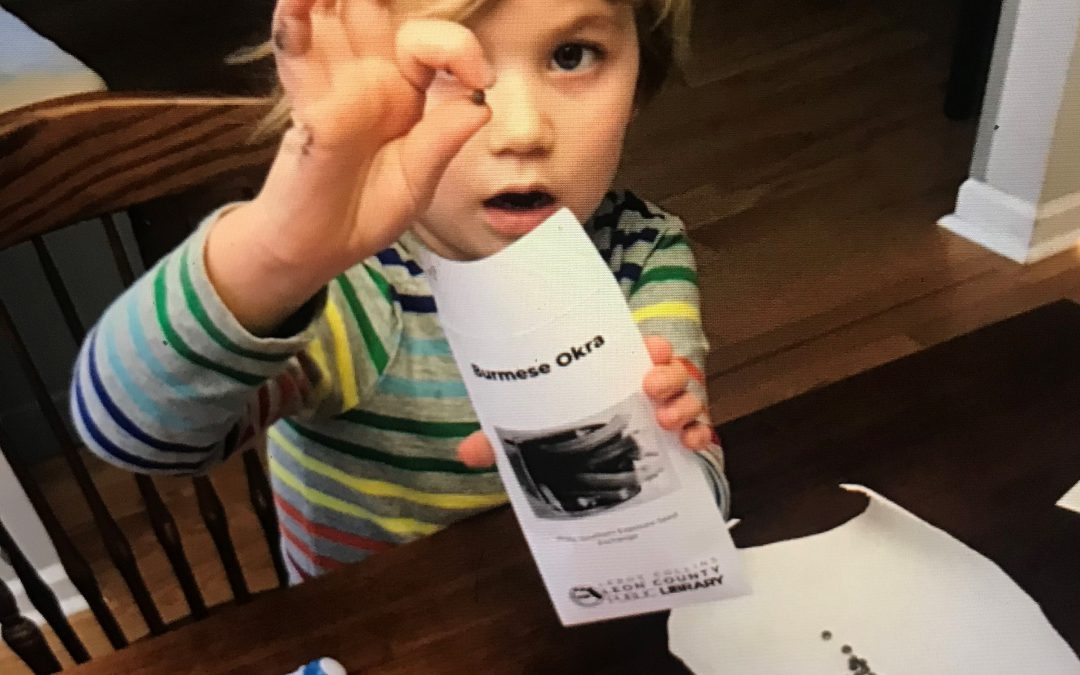
by Molly Jameson | Feb 11, 2021

Sugar snap peas prefer to be planted when the soil is cool and the pods are delicious raw or cooked. Photo by Full Earth Farm.
Leon County’s Spring 2021 Seed Library Program Starts February 13
Although we are still experiencing the coolness of winter, the spring gardening season is right around the corner. To get a head start on the heat that will start taking over by May – and certainly by June – it is important to have a spring garden plan. If you want to start your veggies from seed, certain crops, such as tomatoes, need to be seeded soon for best results. Other warm-loving crops, like squash and cucumbers, also benefit from an early start to beat the life cycles of many common pests.
Need seeds to start your garden? Well, if you live in Leon County, you are in luck. Starting on February 13, 2021, residents of Leon County can “check out” up to three sample seed packets per month with their library card as part of Leon County’s Seed Library Program. The vegetable seeds can be checked out from any of the seven library branch locations. Leon County residents can apply for a library card online at the LeRoy Collins Leon County Public Library online card application page (https://lcpl.ent.sirsi.net/custom/web/registration/).

A young volunteer helped pack seeds from home for the Spring 2021 Leon County Seed Library Program. Photo by Jeanne Breland.
Here are the vegetable seed varieties that will be available starting February 13:
- Italian Large Leaf Basil. This is a fast-growing plant, with four-inch-long green leaves that have an anise flavor and a sweet aroma.
- Jackson Wonder Butterbeans. A high yielding heirloom, these beans produce pods with three to five reddish colored beans in each. When dried, the beans develop a mottled pattern.
- A & C Pickling Cucumber. Plants are productive, producing many straight, dark-green fruits that are great for pickling when they are four to six inches long. Eaten fresh, they can be grown out to 10 inches.
- Edisto 47 Melon. Plants prosper in hot, humid climates and produce mildly sweet five-pound cantaloupes in about 90 days.
- Burmese Okra. Plants have very large leaves and at about 18-inches tall, produce slender curved 9 to 12 inch okra pods that are virtually spineless. Under 10 inches, pods can be eaten raw and are less viscous than some other varieties.
- Sugar Snap Peas. Plants produce sweet, crisp pods that can be eaten raw or cooked. Seeds germinate well in cool soil and plant growth is vigorous, requiring support.
- Corno di Toro Sweet Bell Pepper. This productive pepper, whose name translates to “Horn of the Bull,” produces thick horn-shaped fruit that is flavorful and great eaten raw or cooked.
- Butternut Waltham Squash. This winter squash produces four-to-five-pound fruits with necks that are thick, straight, and cylindrical. The flesh of the fruit is smooth and has a flavor that sweetens with storage.
- Black Krim Tomato. This Russian heirloom has indeterminate growth and produces 8 to16 ounce, brown-to-red fruit with a deep smoky flavor. The shoulders of the tomatoes are brownish green and darken with more heat and sunlight.
- Matt’s Wild Cherry Tomato. This deep-red small cherry tomato has indeterminate growth and produces soft fruit that is very sweet and full of flavor.
Whether you are located in Leon County or not, everyone is welcome to join us Saturday, February 13, from 10:00 a.m. to 12:00 p.m., for our Leon County Seed Library Virtual Workshop. Via Zoom, agents with UF/IFAS Extension Leon County will discuss spring vegetable gardening techniques and food waste prevention. There will also be a live cooking demonstration showing how to prepare healthy meals and snacks at home, featuring vegetables available in the Spring 2021 Seed Library Program.
For more information about the Leon County Seed Library Virtual Workshop, please visit our Eventbrite page: https://spring2021leoncountyseedlibrary.eventbrite.com. There is no cost to attend the workshop, but registration is required.
Happy spring gardening!
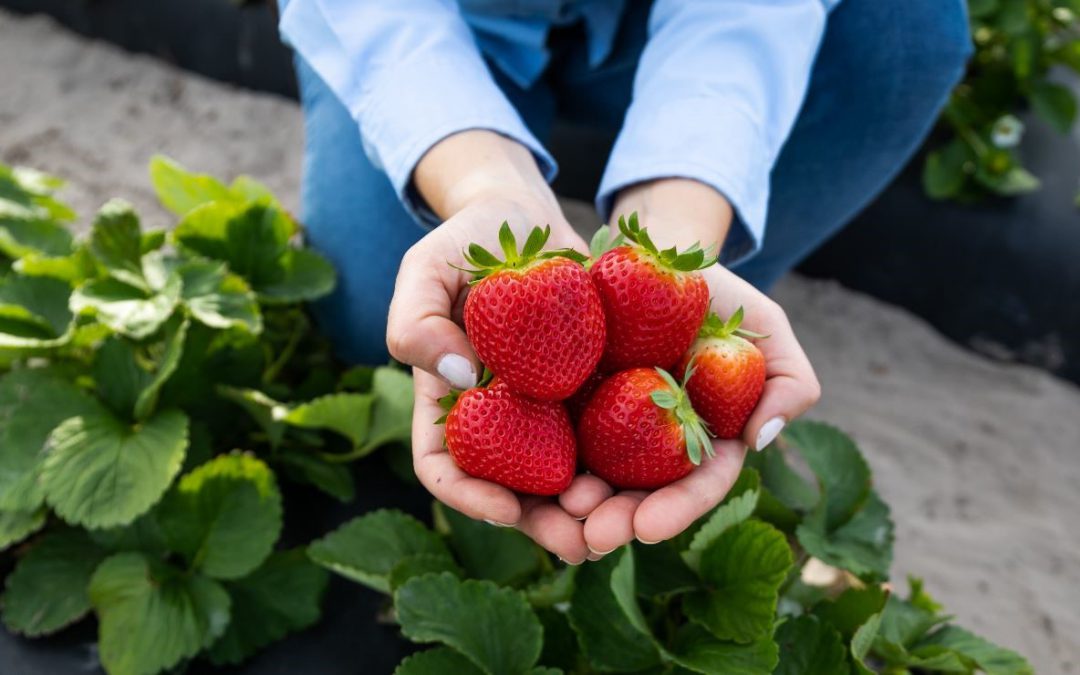
by Ray Bodrey | Nov 4, 2020
Who doesn’t like strawberries, right? Backyard gardeners grow these low-growing herbs throughout the state and there is a significant commercial industry too, as Florida’s climate is ideal for cool season production.
Strawberries like well-drained sandy soils, so they’re a perfect fit for many areas in the Panhandle. Strawberries should be planted in the months of October or November as the plants are quite cold hardy. Shorter days and temperatures between 50°F and 80°F are ideal for fruit development.
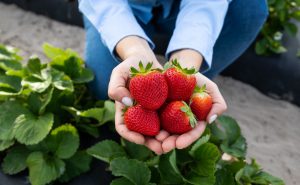
Photo Credit: Cristina Carriz, UF/IFAS
Strawberries are also very versatile. You can plant them in the ground, in raised beds or even containers. Transplants should be planted 12” to 18” apart, with 12” row spacing. For best results, use a rich soil balanced with compost and sandy soil and both fertilize and water regularly. Mixing in 2 ½ pounds of 10-10-10 fertilizer into a 10’ x 10’ bed space should be sufficient to start. A sprinkle of fertilizer applied monthly throughout the growing season should also help ensure a solid yield.
Berry production begins to ramp up roughly 90 days after planting, but plants will continue to produce throughout the spring. When the weather gets warmer, the plants start to expend energy into producing runners instead of fruit. These runners will be new fruit producing plants for next season.
Transplants can be purchased from most garden centers. There are many varieties on the market, but “Florida-Friendly” cultivars include “Sweet Charlie”, “Camarosa”, “Chandler”, “Oso Grande”, “Selva”, and “Festival”. “Camarosa” has proven to be the most productive variety in North Florida. Any of these varieties are capable of producing two pints of fruit per plant.
As stated earlier, Florida has a significant strawberry industry and UF/IFAS has a supporting role. The UF/IFAS Gulf Coast Research and Education Center (GCREC) is home to the Strawberry Breeding Program. Cultivars are developed by traditional means, for the Florida commercial industry on an 11,000+ acres research site. Appearance, shelf life, sweet flavor and disease resistance are just some of the areas of selected breading research that is conducted on site. There is also a white strawberry soon to be released!
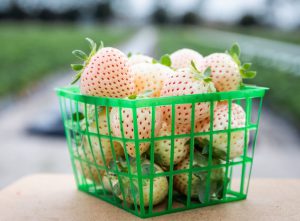
Photo Credit: Cristina Carriz, UF/IFAS
For more information, contact your local county extension office.
Supporting information for this article can be found at the website: https://gardeningsolutions.ifas.ufl.edu/plants/edibles/fruits/strawberries.html
UF/IFAS Extension is an Equal Opportunity Institution.
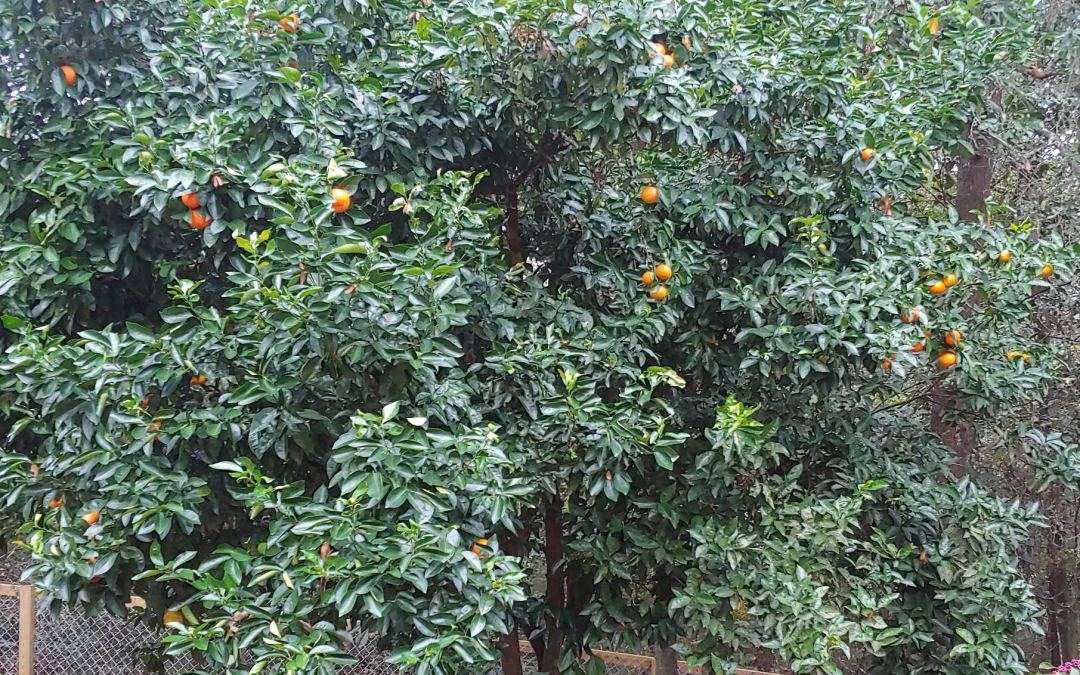
by Matt Lollar | Nov 4, 2020
From time to time we get questions from clients who are unsatisfied with the flavor of the fruit from their citrus trees. Usually the complaints are because of dry or fibrous fruit. This is usually due to irregular irrigation and/or excessive rains during fruit development. However, we sometimes get asked about fruit that is too sour. There are three common reasons why fruit may taste more sour than expected: 1) The fruit came from the rootstock portion of the tree; 2) The fruit wasn’t fully mature when picked; or 3) the tree is infected with Huanglongbing (HLB) a.k.a. citrus greening or yellow dragon disease.
Rootstock
The majority of citrus trees are grafted onto a rootstock. Grafting is the practice of conjoining a plant with desirable fruiting characteristics onto a plant with specific disease resistance, stress tolerance (such as cold tolerance), and/or growth characteristics (such as rooting depth characteristics or dwarfing characteristics). Citrus trees are usually true to seed, but the majority of trees available at nurseries and garden centers are grafted onto a completely different citrus species. Some of the commonly available rootstocks produce sweet fruit, but most produce sour or poor tasting fruit. Common citrus rootstocks include: Swingle orange; sour orange; and trifoliate orange. For a comprehensive list of citrus rootstocks, please visit the Florida Citrus Rootstock Selection Guide. A rootstock will still produce viable shoots, which can become dominant leaders on a tree. In the picture below, a sour orange rootstock is producing a portion of the fruit on the left hand side of this tangerine tree. The trunk coming from the sour orange rootstock has many more spines than the tangerine producing trunks.
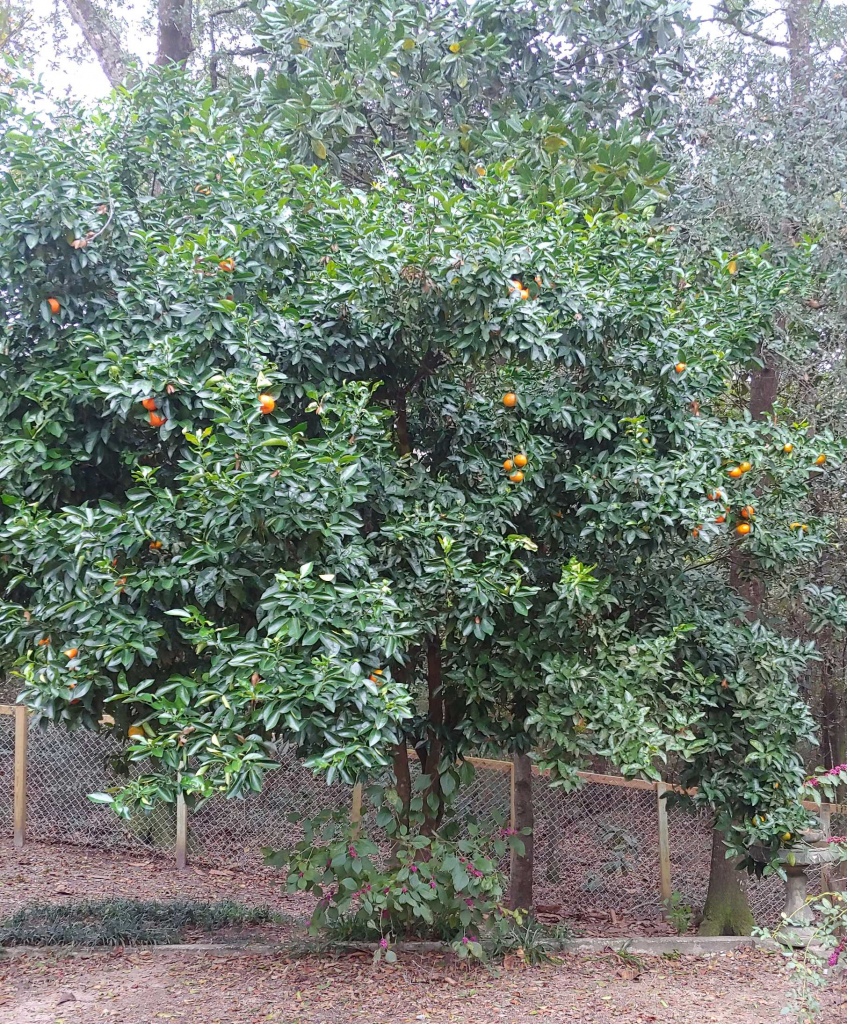
A tangerine tree on a sour orange rootstock that is producing fruit on the left hand side of the tree. Photo Credit: Matt Lollar, University of Florida/IFAS Extension
Fruit Maturity
Florida grown citrus generally matures from the months of October through May depending on species and variety. Satsumas mature in October and taste best after nighttime temperatures drop into the 50s. Most tangerines are mature in late November and December. Oranges and grapefruit are mature December through April depending on variety. The interesting thing about citrus fruit is that they can be stored on the tree after becoming ripe. So when in doubt, harvest only a few fruit at a time to determine the maturity window for your particular tree. A table with Florida citrus ripeness dates can be found at this Florida Citrus Harvest Calendar.
Citrus Greening
Citrus Greening (HLB) is a plant disease caused by the bacterium Candidatus Liberibacter asiaticus, which is vectored by the Asian citrus psyllid. The disease causes the fruit to be misshapen and discolored. The fruit from infected trees does not ripen properly and rarely sweetens up. A list of publications about citrus greening can be found at the link Citrus Greening (Huanglongbing, HLB).

A graphic of various citrus greening symptoms. Photo Credit: University of Florida/IFAS Extension
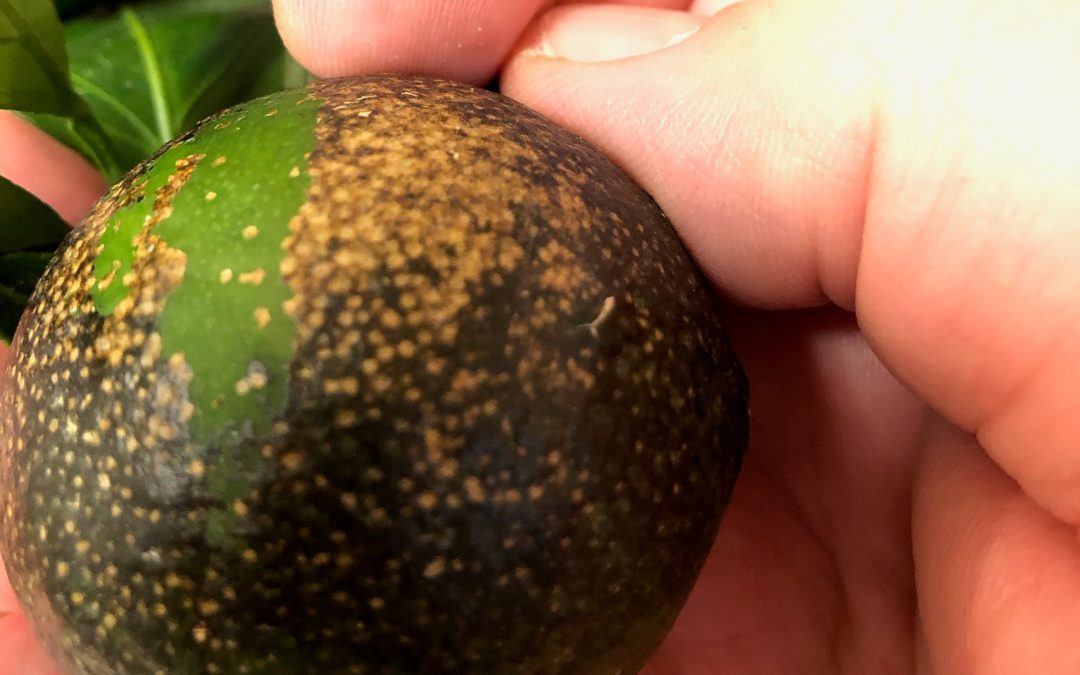
by Matthew Orwat | Aug 31, 2020
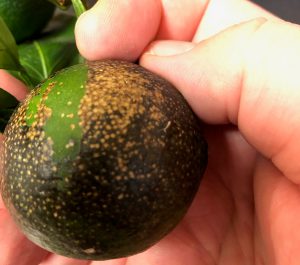
Citrus Rust Mite “sharkskin” closeup – Image Credit Matthew Orwat, UF / IFAS Extension
In recent years, not a summer has gone by in which I did not see citrus rust mite (CRM) damage in a garden. I thought this year would be the first. Unfortunately, recently I saw my first rust mite damage of the year.
Unlike the myriad of pests that have been recently introduced into Florida from abroad, the citrus rust mite (Phyllocoptruta oleivora) has been documented as present in Florida since the late 1800s. Along with its companion, pink citrus rust mite (Aculops pelekassi) It can be a major summer pest for satsuma mandarins grown in the Florida Panhandle gardens.
Citrus Rust Mite (CRM) damage manifests itself on fruit in two ways, “sharkskin” and “bronzing“. Sharkskin is caused when mites have fed on developing fruit, and destroyed the top epidermal layer. As the fruit grows, the epidermal layer breaks and as the fruit heals, the brown “sharkskin” look develops. Bronzing occurs when rust mites feed on fruit that’s nearer to mature size. Since the skin is not fractured by growth, the fruits develop a polished bronze look. In both cases, the interior of the fruit may remain undamaged. However, extreme damage can cases cause fruit drop and reduced fruit size. Regardless of the condition of the interior, damaged fruit is not aesthetically pleasing, but fine for slicing or juicing.
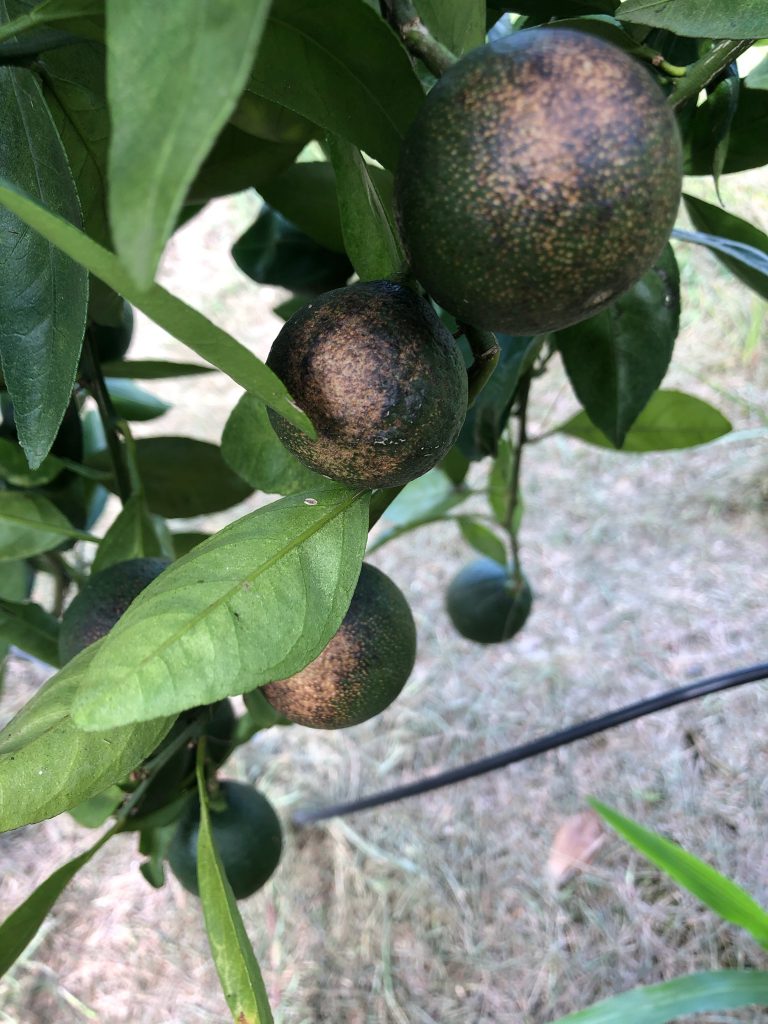
“Sharkskin Damage” to fruit caused by past feeding by the Citrus Rust Mite. Image Credit, Matthew Orwat
If a CRM population is present, they will begin increasing on fresh spring new growth in late April, and usually reach peak levels in June and July. By August the damage has often already been done, but is first noticed due to the increased growth of the fruit. Depending upon weather conditions, CRM can have a resurgence in October and November, just as Satsuma and other citrus is getting ready to be harvested, so careful monitoring is necessary. For more information, check out this publication: Guide to Citrus Rust Mite Identification.

Sun spot resulting from where citrus rust mite avoids feeding on most sun exposed portion of the fruit. Image and Caption courtesy of EDIs publication HS-806
If control of CRM is warranted, there are several miticides available for use, but it is not advisable for home gardeners to use these on their citrus plants since they will also kill beneficial insects. Horticultural oil is an alternative to miticide, which is less damaging to beneficial insects. Several brands of horticultural oil are formulated to smother CRM, but care must be taken to not apply horticultural oil when daytime temperatures will reach 94 degrees Fahrenheit. Application of oils at times when temperatures are at this level or higher will result in leaf and fruit damage.
Although Citrus Rust Mite (CRM) has the potential to be aesthetically unsightly on citrus fruit in the Florida Panhandle, strategies of monitoring and treatment in homeowner citrus production have been successful in mitigating their damage.
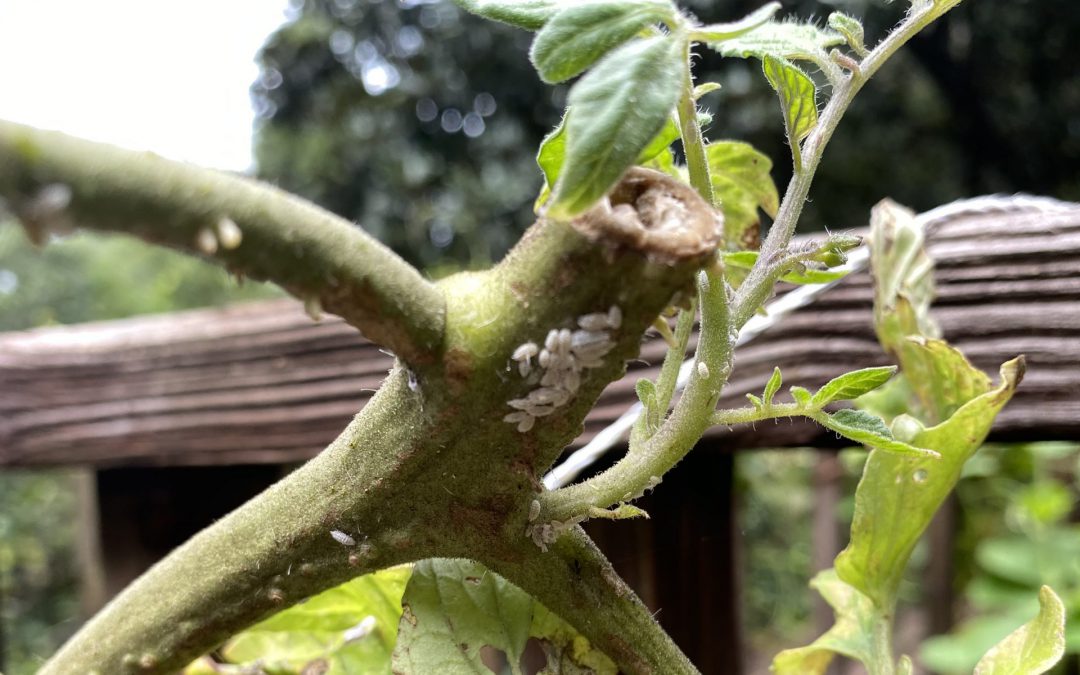
by Matt Lollar | Aug 24, 2020
A common question for gardeners at the end of the season is if one should till the soil or use no till practices. Opinions vary regarding this question, even among Extension Agents. However old crops harbor insects, both good and bad. This phenomenon was noticed on some recently cut back tomato plants. The intention was to cut the leftover spring garden tomatoes back to encourage fall production. Instead, a host plant for mealybugs was provided.

Mealybugs on a tomato plant. Photo Credit: Matt Lollar, University of Florida/IFAS Extension – Santa Rosa County
Mealybugs are soft-bodied insects that possess a covering of flocculent, white, waxy filaments. They are about 1/8 inch in length and usually pinkish or yellowish in color. Mealybugs have piercing-sucking mouthparts which they use to siphon fluids from the leaves, stems, and sometimes roots of many ornamental and vegetable plants. Mealybug damage produces discolored, wilted, and deformed leaves.
One very common example of an insect pest likely to claim residence in your garden’s crop residue, are squash bugs. They like to overwinter on squash, cucumber, and other cucurbit crop residue. If you choose to not till your garden and leave a portion of last seasons crop in your garden, then you should consider applying an insecticide to your spent crop at the end of the season. A product containing a pyrethrin or pyrethroid as an active ingredient would be a good broad spectrum insecticide to control any pest that may reside on plant residue. More information on pyrethrins and pyrehtroids can be found at the EPA webpage: Pyrethrins and Pyrethroids. If you choose to apply an insecticide, it is important that you follow the information on the label regarding pollinator protection. Another option is to plant a trap crop on the edge of your garden to help attract pest insects away from your desired crops. More information on trap crops can be found in the EDIS Publication: Intercropping, Pest Management and Crop Diversity.

An adult squash bug on a zucchini leaf. Photo Credit: Matt Lollar, University of Florida/IFAS Extension – Santa Rosa County
So the answer to the till or no till question is…it depends. It is really up to the gardener. Yes, the residue from crops will add nutrients and organic matter to your soil, but it could also increase pest pressure in your garden. If you don’t plan to remove crop residue and don’t plan to till, then keep an eye out for what could be hiding in your garden.

by Matt Lollar | May 20, 2020
The pawpaw (Asimina triloba) is a native edible that is often overlooked and misunderstood. Not only does it produce a delicious fruit that looks like a mango and tastes like a banana, but it is also an aesthetic landscape plant. This fruit is slowly gaining popularity with younger generations and a handful of universities (Kentucky State University and the University of Missouri) are working on cultivar improvements.
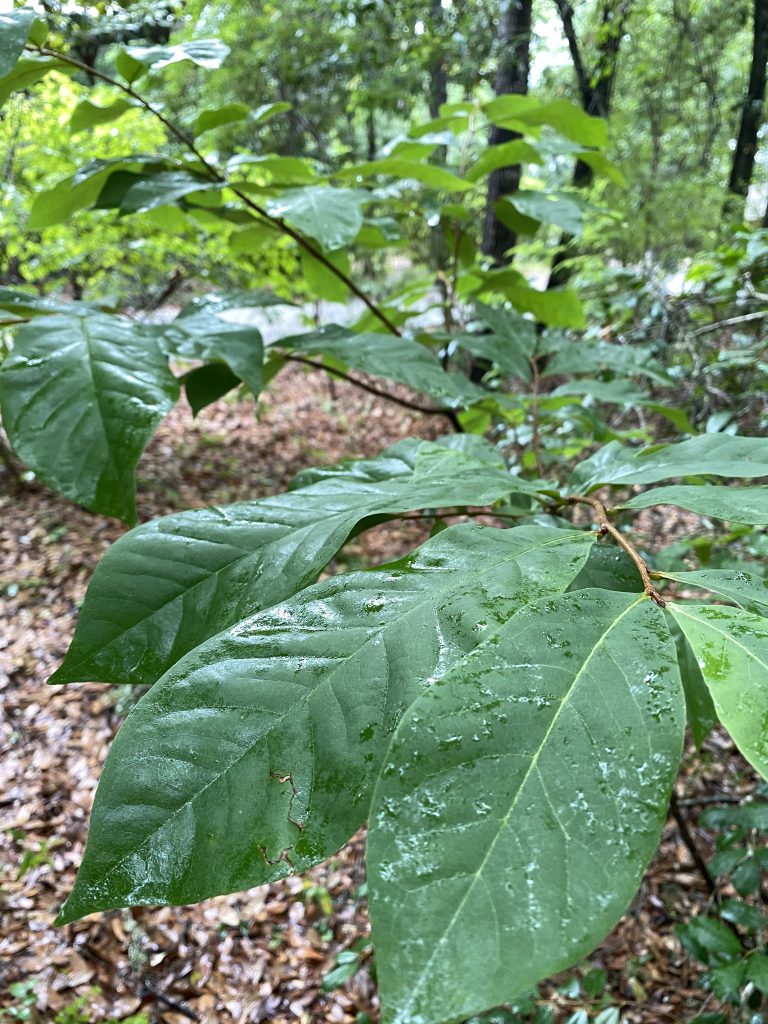
A pawpaw tree growing in the woods. Photo credit: Matt Lollar, University of Florida/IFAS Extension – Santa Rosa County
The pawpaw is native to the eastern United States (USDA Plant Hardiness Zones 5-8), however it’s closest relatives are all tropical such as the custard apple, cherimoya, and soursop. The pawpaw, along with these fruits, are known for their custard-like texture which may be a unpleasant for some consumers. Pawpaws are relatively hardy, have few insect pests, and can still produce fruit in partial shade (although they produce more fruit when grown in full sun).
Pawpaws perform best in moist, well-drained soils with a pH between 5.5 and 7.0. They are found growing wild in full to partial shade, but more fruit are produced when trees are grown in full sun. However, pawpaws need some protection from wind and adequate irrigation in orchard settings. Trees can grow to between 12 feet to 25 feet tall and should be planted at least 15 feet apart. In the Florida Panhandle, flowers bloom in early spring and fruit ripen from August to October depending on variety and weather.
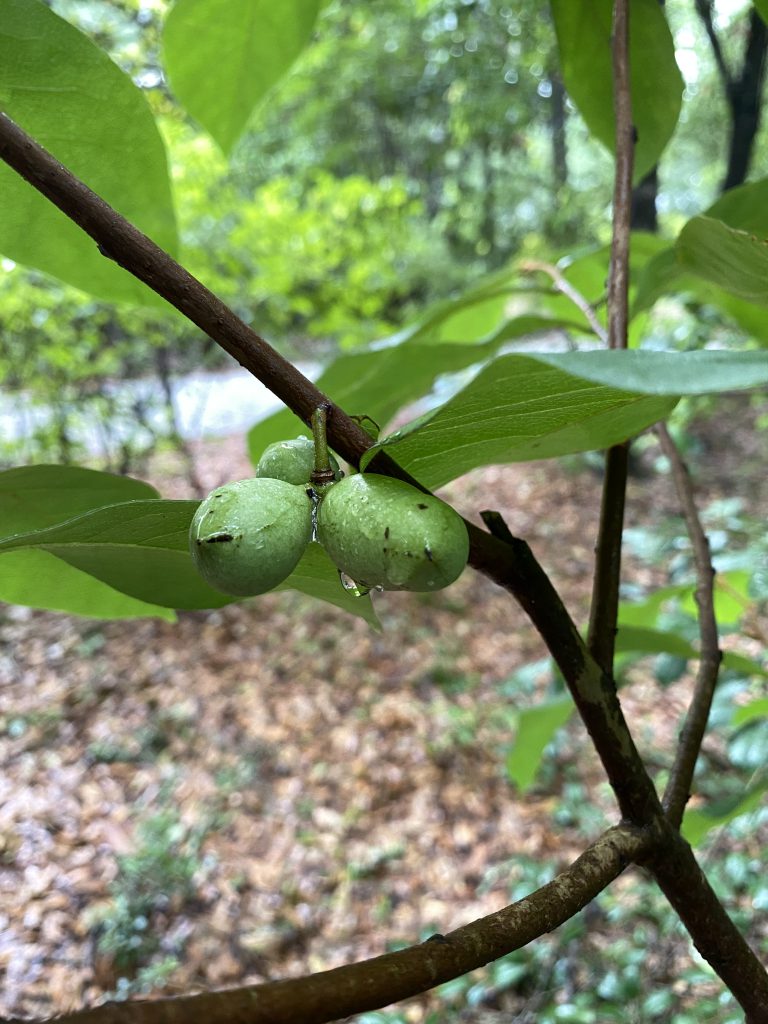
Young pawpaw fruit growing on a small tree. Photo Credit: Matt Lollar, University of Florida/IFAS Extension at Santa Rosa County
A number of improved cultivars of pawpaws have been developed that produce more fruit with more flavor than native seedlings/saplings. The University of Missouri has conducted trials on the following pawpaw cultivars: ‘Sunflower’; ‘PA Golden’; ‘Wells’; ‘NC-1’; ‘Overleese’; ‘Shenandoah’; ‘Susquehanna’; and ’10-35′. Most of these cultivars performed well in southern Missouri, however yields may differ in the Florida Panhandle. The full results of the trial can be found in the “Pawpaw – Unique Native Fruit” publication.
Pawpaws can be propagated by seed or cuttings. Unlike most fruit trees, pawpaws are usually true to seed meaning that saved seed produces a tree with similar characteristics to the parent tree. To save seeds, place fresh seeds in a bag of moist peat moss and refrigerate for 3 to 4 months before planting. To vegetatively propagate, take cuttings (pencil thin in diameter) in the winter and store in a refrigerator until early spring. Cuttings should be chip budded onto seedling rootstock during the spring. Please visit this publication from the University of Nebraska for more information on chip budding.
Pawpaw fruit are ready to harvest when they are slightly soft when gently squeezed. Fruits picked prior to being fully ripe, but after they start to soften, will ripen indoors at room temperature or in a refrigerator. Already-ripe fruit will stay fresh for a few days at room temperature or for a few weeks in the refrigerator. To enjoy pawpaw fruit throughout the year, scoop out the flesh, remove the seeds, and place the flesh in freezer bags and freeze.
Whether you want to add more native plants to your landscape or you are a rare and unusual fruit enthusiast, pawpaw may be the tree for you. They can be utilized as a focal point in the garden and provide delicious fruit for your family. For more information on pawpaw or other fruit trees, please contact your local Extension Office.



















